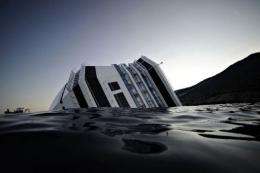Picture taken on January 14, 2012 shows the Costa Concordia after the cruise ship ran aground and keeled over off the Isola del Giglio. Salvage workers Sunday began pumping fuel from the shipwrecked Italian cruise liner Costa Concordia, a day ahead of schedule, officials said.
Salvage workers Sunday began pumping fuel from the shipwrecked Italian cruise liner Costa Concordia, a day ahead of schedule, officials said.
Operations began at around 5:00 pm (1600 GMT) on the wreck off the Tuscan island of Giglio to remove fuel from seven of the massive ship's tanks, with conditions calm.
The Costa Concordia ran aground on January 13 with a total of 4,229 people on board, an accident that cost the lives of 32 people. The bodies of 15 of those lost have still to be recovered.
Civil protection officials had originally said they would start the pumping operations on Monday, but preparations were completed ahead of time.
Dutch company Smit, working with the Italian firm Neri, is handling the operation, which will involve extracting 2,400 tonnes of fuel still inside the vessel to avoid what officials say would be an environmental disaster if it leaked into the sea.
They plan to complete the operation in 28 days, working around the clock to empty a total of 15 tanks, so long as weather conditions permit, the civil protection authority said.
Only once that operation is completed can work begin to refloat the vessel, an operation that experts say will take at least seven months and possibly as many as 10.
The Costa Concordia ran aground just a few dozen metres (yards) from the port of the island of Giglio, which lies off Italy's Tuscan coast and from where ferries run to the mainland.
Pierluigi Foschi, the chief executive of Costa Crociere, owners of the cruise liner, visited the tiny island of Giglio, which has 800 inhabitants, on Thursday.
He told local people they would have a concrete plan by the middle of March on getting the vessel out of their waters and promised to everything he could to minimise the impact on the local tourist industry.
(c) 2012 AFP
























